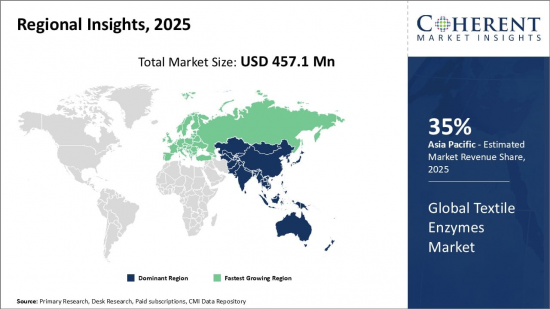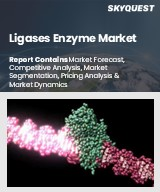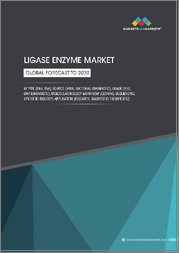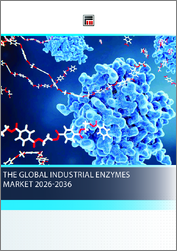
|
시장보고서
상품코드
1708318
세계의 섬유 효소 시장 : 원료별, 유형별, 용도별, 지역별Global Textile Enzymes Market, By Source, By Type, By Application, By Geography |
||||||
세계의 섬유 효소 시장은 2025년에는 4억 5,710만 달러에 달하고, 2032년에는 7억 560만 달러에 이를 것으로 예측되고, 2025년부터 2032년까지의 CAGR은 6.4%를 나타낼 것으로 전망됩니다.
| 보고 범위 | 보고서 세부정보 | ||
|---|---|---|---|
| 기준 연도 | 2024년 | 시장 규모(2025년) | 4억 5,710만 달러 |
| 실적 데이터 | 2020-2024년 | 예측 기간 | 2025-2032년 |
| 예측 기간 : 2025-2032년 CAGR : | 6.40% | 가치 예측(2032년) | 7억 560만 달러 |

섬유 산업은 지난 수십년 동안 현저한 성장을 이루었습니다. 다양한 특성을 향상시키는 데 도움이 됩니다. 효소는 발효를 통해 미생물 공급원에서 파생되며 제조, 염색, 바이오 연마 및 기타 섬유 가공에 친환경 솔루션을 제공합니다. 우리는 가까운 미래에 크게 확대될 것으로 예측됩니다. 섬유에 대한 효소는 가공 효율을 향상시키고 고품질의 완성 된 섬유 제품을 생산하는 데 도움이 됩니다. 수요가 높아짐에 따라 견인되고 있습니다. 섬유 효소는 가공에 있어서의 화학약품과 물의 사용을 삭감하는 동시에, 보다 높은 생산율을 가능하게 합니다.
시장 역학 :
섬유 효소 시장을 촉진하는 주요 요인으로는 소비자의 환경 의식이 높아지고 섬유 생산에 있어서의 유독 화학물질의 사용에 관한 정부의 엄격한 규제 등이 있습니다. 보다 저렴한 화학물질로 대용할 수 있는 것이, 계속해서 시장 성장을 억제하고 있습니다.보다 효과적이고 안정된 공업용 효소를 개발하기 위한 효소 공학 기술 시장 개척은 시장 확대의 호기가 됩니다.
본 조사의 주요 특징
본 보고서에서는 섬유 효소 시장을 상세하게 분석하여 2024년을 기준 연도로 한 예측기간(2025-2032년) 시장 규모 및 복합연간 성장률(CAGR)을 제공합니다.
또한 다양한 부문에 걸친 잠재적인 수익 기회를 밝히고 이 시장의 매력적인 투자 제안 행렬을 설명합니다.
또한 시장 성장 촉진요인, 성장 억제요인, 기회, 신제품의 출시와 승인, 시장 동향, 지역별 전망, 주요 기업이 채용하는 경쟁 전략 등에 관한 주요 인사이트도 제공합니다.
기업 하이라이트, 제품 포트폴리오, 주요 하이라이트, 재무 실적, 전략 등의 매개변수를 기반으로 섬유 효소 시장 주요 기업을 프로파일링합니다.
본 조사의 대상이 되는 주요 기업으로는 노보자임스, 다우듀폰, BASF, DSM, Sunson Industry Group, Lenzing AG 등이 포함됩니다.
이 보고서의 인사이트를 통해 마케팅 담당자와 기업 경영진은 향후 제품 출시, 타이핑, 시장 확대, 마케팅 전술에 대한 정보를 바탕으로 의사 결정을 내릴 수 있습니다.
섬유 효소 시장 보고서는 투자자, 공급업체, 제품 제조업체, 유통업체, 신규 참가자, 재무 분석가 등 이 업계의 다양한 이해관계자를 지원합니다.
제1장 조사의 목적과 전제조건
- 조사 목적
- 전제조건
- 약어
제2장 시장 개요
- 보고서 설명
- 시장 정의와 범위
- 주요 요약
제3장 주요 업계 인사이트
- 시장 역학
- 성장 촉진요인
- 성장 억제요인
- 기회
- 영향 분석
- PEST 분석
- Porter's Five Forces 분석
- 기술의 진보
- 합병, 인수, 협업 시나리오
- 최근 제품 승인/발매
- 기업의 시장 점유율 분석
제4장 섬유 효소 시장, 원료별(2020-2032년)
- 동물 조직
- 식물
- 미생물
제5장 섬유 효소 시장, 유형별(2020-2032년)
- 아밀라아제
- 셀룰라아제
- 리파제
- 프로테아제
- 펙티나제
- 라카제
- 기타 유형
제6장 섬유 효소 시장, 용도별(2020-2032년)
- 디사이징
- 바이오 폴리싱
- 표백
- 바이오 소싱
- 기타 용도
제7장 섬유 효소 시장, 지역별(2020-2032년)
- 지역별
- 북미
- 유럽
- 아시아태평양
- 중동 및 아프리카
- 라틴아메리카
제8장 기업 프로파일-섬유 효소 시장
- EPYGEN LABS LLC.
- 기업 개요
- 제품/서비스 포트폴리오
- 재무실적
- 최근 동향/업데이트
- 전략 개요
- Sunsong Industry Group Co., Ltd.
- Noor Enzymes, Antozyme Biotech Pvt. Ltd.
- Nature BioScience Pvt. LTD
- Tex Biosciences(P) Ltd., Infinita Biotech Private Limited
- Novozymes, BESTZYME BIO-ENGINEERING CO., LTD.
- AB Enzymes
- BASF SE
- DENYKEM
- DSM
- Kemin Industries, Inc.
- Advanced Enzyme Technologies
- Ultreze
제9장 참고문헌과 조사 방법
- 참고문헌
- 조사 방법
Global Textile Enzymes Market is estimated to be valued at USD 457.1 Mn in 2025 and is expected to reach USD 705.6 Mn by 2032, growing at a compound annual growth rate (CAGR) of 6.4% from 2025 to 2032.
| Report Coverage | Report Details | ||
|---|---|---|---|
| Base Year: | 2024 | Market Size in 2025: | USD 457.1 Mn |
| Historical Data for: | 2020 To 2024 | Forecast Period: | 2025 To 2032 |
| Forecast Period 2025 to 2032 CAGR: | 6.40% | 2032 Value Projection: | USD 705.6 Mn |

The textile industry has witnessed significant growth over the past few decades. With rising demand for improved functionality, durability, and appearance of textile fabrics, enzymes have emerged as promising agents in textile processing. Textile enzymes help enhance various properties of fabrics without the use of harsh chemicals. They are derived from microbial sources through fermentation and offer eco-friendly solutions for preparation, dyeing, bio-polishing, and other textile processes. The textile enzymes market is projected to expand substantially in the near future due to growing popularity of bio-based chemicals in textile manufacturing. They help improve the efficiency of processing and yield better quality finished textiles. The global textile enzymes market is driven by the growing demand for bio-based and eco-friendly processes in the textile industry. Textile enzymes reduce the use of chemicals and water in processing while allowing higher production rates. Their usage helps textile manufacturers lower costs and minimize environmental impact.
Market Dynamics:
The key drivers fueling the textile enzymes market include growing environmental awareness among consumers and stringent government regulations regarding the use of toxic chemicals in textile production. Enzymes help reduce water consumption and lower emissions of pollutants compared to traditional chemical-based processes. However, high initial investment costs for enzymatic treatment systems and the availability of cheaper chemical substitutes continue to restrain the market growth. Advancements in enzyme engineering technologies to develop more effective and stable enzymes for industrial use present lucrative opportunities for market expansion. Major =market players are focusing on research and development (R&D) to introduce cost-effective and customized enzyme solutions tailored to specific textile processing needs.
Key features of the study:
This report provides in-depth analysis of the textile enzymes market, and provides market size (US$ Mn) and compound annual growth rate (CAGR %) for the forecast period (2025-2032), considering 2024 as the base year.
It elucidates potential revenue opportunities across different segments and explains attractive investment proposition matrices for this market
This study also provides key insights about market drivers, restraints, opportunities, new product launches or approval, market trends, regional outlook, and competitive strategies adopted by key players
It profiles key players in the textile enzymes market based on the following parameters - company highlights, products portfolio, key highlights, financial performance, and strategies
Key companies covered as a part of this study include Novozymes, Dowdupont, BASF, DSM, Sunson Industry Group and Lenzing AG
Insights from this report would allow marketers and the management authorities of the companies to make informed decisions regarding their future product launches, type up-gradation, market expansion, and marketing tactics
The textile enzymes market report caters to various stakeholders in this industry including investors, suppliers, product manufacturers, distributors, new entrants, and financial analysts
Detailed Segmentation
- Global Textile Enzymes Market, By Source
- Animal Tissues
- Plants
- Micro-organisms
- Global Textile Enzymes Market, By Type
- Amylases
- Cellulase
- Lipases
- Proteases
- Pectinases
- Laccases
- Other Types
- Global Textile Enzymes Market, By Application
- De-Sizing
- Bio-Polishing
- Bleaching
- Bio-Sourcing
- Other Applications
- Global Textile Enzymes Market, By Region
- North America
- Europe
- Asia Pacific
- Latin America
- Middle East
- Africa
- Company Profiles
- EPYGEN LABS LLC.
- Sunsong Industry Group Co., Ltd.
- Noor Enzymes
- Antozyme Biotech Pvt. Ltd.
- Nature BioScience Pvt. L.T.D.
- Tex Biosciences (P) Ltd.
- Infinita Biotech Private Limited
- Novozymes
- BESTZYME BIO-ENGINEERING CO., LTD.
- AB Enzymes
- BASF SE
- DENYKEM
- DSM
- Kemin Industries, Inc.
- Advanced Enzyme Technologies
- Ultreze
Table Of Content
1. Research Objectives and Assumptions
- Research Objectives
- Assumptions
- Abbreviations
2. Market Overview
- Report Description
- Market Definition and Scope
- Executive Summary
- Top 3 Market Findings
- Top 3 Market Opportunity
3. Key Industry Insights
- Market Dynamics
- Drivers
- Restraints
- Opportunities
- Impact Analysis
- Pest Analysis
- Porters Analysis
- Technological Advancement
- Merger, Acquisition and Collaboration Scenario
- Recent Product Approvals/Launches
- Company Market Share Analysis
4. Textile Enzymes Market, By Source, 2020 - 2032 ( US$ Million)
- Introduction
- Market Size and Forecast, 2020 - 2032, ( US$ Million)
- Segment Trends
- Animal Tissues, 2020 - 2032( US$ Million)
- Introduction
- Market Size and Forecast, 2020 - 2032, ( US$ Million)
- Plants, 2020 - 2032( US$ Million)
- Introduction
- Market Size and Forecast, 2020 - 2032, ( US$ Million)
- Micro-organisms, 2020 - 2032( US$ Million)
- Introduction
- Market Size and Forecast, 2020 - 2032, ( US$ Million)
5. Textile Enzymes Market, By Type, 2020 - 2032 ( US$ Million)
- Introduction
- Market Size and Forecast, 2020 - 2032, ( US$ Million)
- Segment Trends
- Amylases, 2020 - 2032( US$ Million)
- Introduction
- Market Size and Forecast, 2020 - 2032, ( US$ Million)
- Cellulase, 2020 - 2032( US$ Million)
- Introduction
- Market Size and Forecast, 2020 - 2032, ( US$ Million)
- Lipases, 2020 - 2032( US$ Million)
- Introduction
- Market Size and Forecast, 2020 - 2032, ( US$ Million)
- Proteases, 2020 - 2032( US$ Million)
- Introduction
- Market Size and Forecast, 2020 - 2032, ( US$ Million)
- Pectinases, 2020 - 2032( US$ Million)
- Introduction
- Market Size and Forecast, 2020 - 2032, ( US$ Million)
- Laccases, 2020 - 2032( US$ Million)
- Introduction
- Market Size and Forecast, 2020 - 2032, ( US$ Million)
- Other Types, 2020 - 2032( US$ Million)
- Introduction
- Market Size and Forecast, 2020 - 2032, ( US$ Million)
6. Textile Enzymes Market, By Application, 2020 - 2032 ( US$ Million)
- Introduction
- Market Size and Forecast, 2020 - 2032, ( US$ Million)
- Segment Trends
- De-sizing, 2020 - 2032( US$ Million)
- Introduction
- Market Size and Forecast, 2020 - 2032, ( US$ Million)
- Bio-polishing, 2020 - 2032( US$ Million)
- Introduction
- Market Size and Forecast, 2020 - 2032, ( US$ Million)
- Bleaching, 2020 - 2032( US$ Million)
- Introduction
- Market Size and Forecast, 2020 - 2032, ( US$ Million)
- Bio-sourcing, 2020 - 2032( US$ Million)
- Introduction
- Market Size and Forecast, 2020 - 2032, ( US$ Million)
- Other Applications, 2020 - 2032( US$ Million)
- Introduction
- Market Size and Forecast, 2020 - 2032, ( US$ Million)
7. Textile Enzymes Market, By Region, 2020 - 2032 ( US$ Million)
- Introduction
- Market Share Analysis, 2020 - 2032, ( US$ Million)
- Segment Trends
- By Region
- Introduction
- Market Size and Forecast, 2020 - 2032, ( US$ Million)
- North America
- Introduction
- Market Size and Forecast, By Source, 2020 - 2032, ( US$ Million)
- Market Size and Forecast, By Type, 2020 - 2032, ( US$ Million)
- Market Size and Forecast, By Application, 2020 - 2032, ( US$ Million)
- Market Size and Forecast, By Country, 2020 - 2032, ( US$ Million)
- U.S.
- Canada
- Europe
- Introduction
- Market Size and Forecast, By Source, 2020 - 2032, ( US$ Million)
- Market Size and Forecast, By Type, 2020 - 2032, ( US$ Million)
- Market Size and Forecast, By Application, 2020 - 2032, ( US$ Million)
- Market Size and Forecast, By Country, 2020 - 2032, ( US$ Million)
- U.K.
- Germany
- Italy
- France
- Spain
- Russia
- Rest Of Europe
- Asia Pacific
- Introduction
- Market Size and Forecast, By Source, 2020 - 2032, ( US$ Million)
- Market Size and Forecast, By Type, 2020 - 2032, ( US$ Million)
- Market Size and Forecast, By Application, 2020 - 2032, ( US$ Million)
- Market Size and Forecast, By Country, 2020 - 2032, ( US$ Million)
- China
- India
- Japan
- Australia
- South Korea
- Asean
- Rest Of Asia Pacific
- Middle East & Africa
- Introduction
- Market Size and Forecast, By Source, 2020 - 2032, ( US$ Million)
- Market Size and Forecast, By Type, 2020 - 2032, ( US$ Million)
- Market Size and Forecast, By Application, 2020 - 2032, ( US$ Million)
- Market Size and Forecast, By Country, 2020 - 2032, ( US$ Million)
- GCC
- Israel
- Rest Of Middle East
- Latin America
- Introduction
- Market Size and Forecast, By Source, 2020 - 2032, ( US$ Million)
- Market Size and Forecast, By Type, 2020 - 2032, ( US$ Million)
- Market Size and Forecast, By Application, 2020 - 2032, ( US$ Million)
- Market Size and Forecast, By Country, 2020 - 2032, ( US$ Million)
- Brazil
- Mexico
- Argentina
8. Company Profiles - Textile Enzymes Market
- EPYGEN LABS LLC.
- Company Overview
- Product/Service Portfolio
- Financial Performance
- Recent Developments/Updates
- Strategic Overview
- Sunsong Industry Group Co., Ltd.
- Noor Enzymes, Antozyme Biotech Pvt. Ltd.
- Nature BioScience Pvt. L.T.D.
- Tex Biosciences (P) Ltd., Infinita Biotech Private Limited
- Novozymes, BESTZYME BIO-ENGINEERING CO., LTD.
- AB Enzymes
- BASF SE
- DENYKEM
- DSM
- Kemin Industries, Inc.
- Advanced Enzyme Technologies
- Ultreze
9. References and Research Methodology
- References
- Research Methodology
- About us and Sales Contact



















